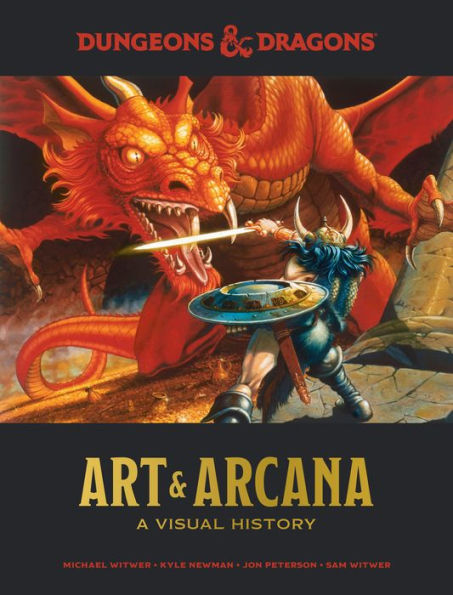Read an Excerpt
From the INTRODUCTION
If it's true that we live in an era when it is “chic to be geek,” then Dungeons & Dragons is just about the coolest thing out there. It was, it is, and it always will be the game of the geeks, but its fandom is no longer so neatly contained. Once an esoteric diversion known only to a small but passionate group of wargamers, the game and the foundational concepts that it brought forth became among the most influential phenomena of the Information Age. The reason? The game’s earliest adopters happened to share an interest in other “geeky” things like computers, electronics, digital technologies, visual effects, filmmaking, performing arts, and beyond. These geeks grew up to develop the social and business infrastructure of the twenty-first century using concepts they had once learned on poorly lit tabletops set in dining rooms and basements. Dungeons & Dragons, according to Wired editor Adam Rogers, “allowed geeks to venture out of our dungeons, blinking against the light, just in time to create the present age of electronic miracles.” It is indeed chic to be geek, and the prophesy has finally been fulfilled: the geek shall inherit the Earth (and the parallel D&D world of Oerth).
Today, if you are one of the millions of subscribers to an MMO (massively multiplayer online game)such as World of Warcraft; a tourist in the exotic worlds of a computer role-playing franchise such as Final Fantasy or The Elder Scrolls; a virtual marksman in any first-person-shooter video game; a lover of modern fantasy television, films, or literature such as Game of Thrones; or even anyone who has ever “leveled up” in a game or rewards program, then you have Dungeons & Dragons to thank. Simply put, D&D has either directly or indirectly influenced them all. John Romero, co-creatorof the seminal first-person-shooter Doom, attributes his success to D&D, calling it “the most influential game,” adding that “the gaming concepts put forth by D&D inspired the earliest groups of gamers and computer programmers, and set into motion a revolution of creative and technical innovation.” The numbers of actors and directors who credit the game with providing them inspiration is immense, from Vin Diesel and Stephen Colbert to Rainn Wilson and the late Robin Williams. Celebrated director Jon Favreau suggested the game gave him “a really strong background in imagination, storytelling,understanding how to create tone and a sense of balance.” National Book Award–winner Ta-Nehisi Coates agrees, suggesting the game helped introduce him to “the powers of imagination.” All this is to say, the story of D&D is as important now as it has ever been, and with the recent success of 5th edition and an array of D&D-inspired blockbuster books, shows, and films surfacing, from Ready Player One to Stranger Things, its history will become increasingly visible and relevant.
Nothing conveys the story of D&D better than its visuals. At a time when fantasy and science fiction were, at best, fringe diversions, D&D was creating a culture of do-it-yourself fantasy world-building through its immersive narrative environments, given life by its ever-evolving illustrations and artwork. It depicted monsters, magic, swords, and sorcery in a way that taught fans a visual vocabulary of the unreal, fixing in the minds of a whole generation how to picture the fantastic. The relationship between Dungeons & Dragons and its artwork goes beyond symbiosis, but to outright reliance—one simply couldn’t exist without the other. The art informed the game, and the game informed the art. Beginning as amateur, homebrew sketches used to illustrate to the initiated simple concepts such as maps and the physical appearance of monsters, characters, and weapons, the art of D&D rapidly became an essential teaching tool as the game reached wider audiences less familiar with some of its fundamental concepts. The illustrations quickly had to become instructional in nature, helping players to not only conceptualize the landscapes, inhabitants, and equipment of the imagined world, but even how to use them in the context of the game. Soon the game and its fandom demanded even greater levels of sophistication—ful lcolor artwork with higher and higher levels of character andcomposition. This movement gave way to a wave of master artists who eventually developed the most important and influential fantasy art from the late 1970s to today—a collection simply unsurpassed in the fantasy genre.
The book you are holding is the dynamic story of this incredible game as told through its incomparable imagery, as well as the story of the visuals themselves. It is a carefully curated selection of art, advertising, and ephemera that we feel best represents D&D’s incredible forty-plus-year journey—a visual archive that tells a remarkable story of evolution, innovation, turmoil, perseverance, and ultimately triumph. While we expect that much of the enclosed imagery will be at least remotely familiar to D&D aficionados, the collection that follows includes numerous one-of-a-kind rarities, many of which have never been released to the public. We truly hope that you enjoy what you read and see, and that you as readers might approach this piece the same way we did—with unadulterated passion and a taste for adventure. After all, this is an adventure module of sorts, one that is intended for you personally, just as it has been for each of us. “So enjoy, and may the dice be good to you!”


